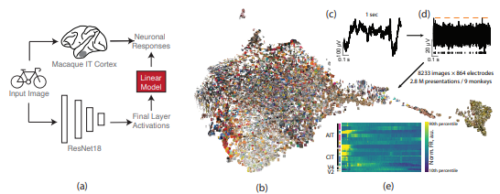2025-01-06 ハーバード大学
<関連情報>
- https://seas.harvard.edu/news/2025/01/evaluating-how-brains-generalize
- https://arxiv.org/abs/2406.16935
腹側視覚野のDNNに基づく符号化モデルの分布外汎化能力のベンチマーキング Benchmarking Out-of-Distribution Generalization Capabilities of DNN-based Encoding Models for the Ventral Visual Cortex
Spandan Madan, Will Xiao, Mingran Cao, Hanspeter Pfister, Margaret Livingstone, Gabriel Kreiman
arXiv Submitted on 16 Jun 2024
DOI:https://doi.org/10.48550/arXiv.2406.16935

Abstract
We characterized the generalization capabilities of DNN-based encoding models when predicting neuronal responses from the visual cortex. We collected \textit{MacaqueITBench}, a large-scale dataset of neural population responses from the macaque inferior temporal (IT) cortex to over 300,000 images, comprising 8,233 unique natural images presented to seven monkeys over 109 sessions. Using \textit{MacaqueITBench}, we investigated the impact of distribution shifts on models predicting neural activity by dividing the images into Out-Of-Distribution (OOD) train and test splits. The OOD splits included several different image-computable types including image contrast, hue, intensity, temperature, and saturation. Compared to the performance on in-distribution test images — the conventional way these models have been evaluated — models performed worse at predicting neuronal responses to out-of-distribution images, retaining as little as 20% of the performance on in-distribution test images. The generalization performance under OOD shifts can be well accounted by a simple image similarity metric — the cosine distance between image representations extracted from a pre-trained object recognition model is a strong predictor of neural predictivity under different distribution shifts. The dataset of images, neuronal firing rate recordings, and computational benchmarks are hosted publicly at: this https URL.


